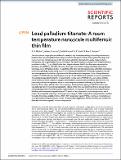Lead palladium titanate : a room temperature nanoscale multiferroic thin film
Date
19/02/2020Metadata
Show full item recordAbstract
The discovery of single-phase multiferroic materials and the understanding of coupling mechanisms between their spin and polarization is important from the point of view of next generation logic and memory devices. Herein we report the fabrication, dielectric, ferroelectric, piezo-response force microscopy, and magnetization measurements of Pd-substituted room-temperature magnetoelectric multiferroic PbPd0.3Ti0.7O3 (PbPdT) thin films. Highly oriented PbPdT thin films were deposited on {(LaAlO3)0.3(Sr2AlTaO6)0.7} (LSAT) substrates in oxygen atmosphere using pulsed laser deposition technique. X-ray diffraction studies revealed that the films had tetragonal phase with (001) orientation. Surface morphology studies using atomic force and scanning electron microscopy suggest a smooth and homogeneous distribution of grains on the film surface with roughness ~2 nm. A large dielectric constant of ~1700 and a low-loss tangent value of ~0.3 at 10 kHz were obtained at room temperature. Temperature dependent dielectric measurements carried out on Pt/PbPdT/La0.7Sr0.3MnO3 (LSMO) metal-dielectric-metal capacitors suggest a ferroelectric to paraelectric transition above 670 K. The measured polarization hysteresis loops at room temperature were attributed to its ferroelectric behavior. From a Tauc plot of (αhν)2 versus energy, the direct band gap Eg of PbPdT thin films was calculated as 3 eV. Ferroelectric piezoelectric nature of the films was confirmed from a strong domain switching response revealed from piezo-response force microscopy. A well-saturated magnetization M-H loop with remanent magnetization of 3.5 emu/cm3 was observed at room temperature, and it retains ferromagnetic ordering in the temperature range 5–395 K. Origin of the magnetization could be traced to the mixed oxidation states of Pd2+/Pd4+ dispersed in polar PbTiO3 matrix, as revealed by our x-ray photoelectron spectroscopic results. These results suggest that PbPdT thin films are multiferroic (ferroelectric-ferromagnetic) at room temperature.
Citation
Mishra , K K , Instan , A A , Kumari , S , Scott , J F & Katiyar , R S 2020 , ' Lead palladium titanate : a room temperature nanoscale multiferroic thin film ' , Scientific Reports , vol. 10 , 2991 . https://doi.org/10.1038/s41598-020-59961-w
Publication
Scientific Reports
Status
Peer reviewed
ISSN
2045-2322Type
Journal article
Description
The authors acknowledge the financial support from the Department of Defense, USA (DoD Grant No. FA9550-16-1-0295).Collections
Items in the St Andrews Research Repository are protected by copyright, with all rights reserved, unless otherwise indicated.

